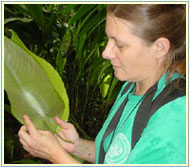The Great Caterpillar Hunt
One of our main jobs while we are here is to help the scientists, Lee and Grant find as many caterpillars as possible. There are over a hundred species of butterflies and moths in the area. However, if you try to look them up in a book, you quickly find out there is not much information about them. In fact, scientists don't know the host plants that many caterpillars depend on during their life times. One purpose of this project is to find out what the caterpillars eat and more about their life histories.
Today our search for caterpillars took us to the successional plots. Succession refers to how certain species of plants colonize an area. These plants need a lot of sun and do better than other plants when the plots are first cleared. However, as they grow, the shade they create allows other plants to flourish. Eventually you get a whole different community of plants and tress. These five small plots are cut down every five years so scientists can study how and when the plants grow back. The successional plots are great areas in which to find caterpillars because the plants are a bit shorter and the caterpillars are easier to find.
 |
 |
 |

Here I am looking at a caterpillar on a big leaf.
|
 |
 |
 |
We spent the morning walking between and inside the plots looking for caterpillars. When we find a caterpillar, we carefully cut a piece of the plant that it is on and record information about the caterpillar's appearance and behavior. Is it camouflaged or brightly colored? Does it make a shelter? Is it hairy or smooth? We also poke at it gently with a paintbrush or small forceps to see how it tries to defend itself. Does it try to bite or thrash about or drop off the leaf? Lastly, we put the caterpillar and leaves from the plant it was on in a bag to take back to the "zoo."
Today's collecting journey took us on a walk through the swampy portion of the reserve. The path was muddy and sticky but the forest was beautiful. Our path took us back and forth over the same river three times. We originally planned to eat lunch at one of the bridges but found that it had been washed away. We ended up crossing over on a log and eating lunch on a hillside while spider monkeys swung around overhead.
Photos courtesy of Shauneen Giudice/Earthwatch Institute

